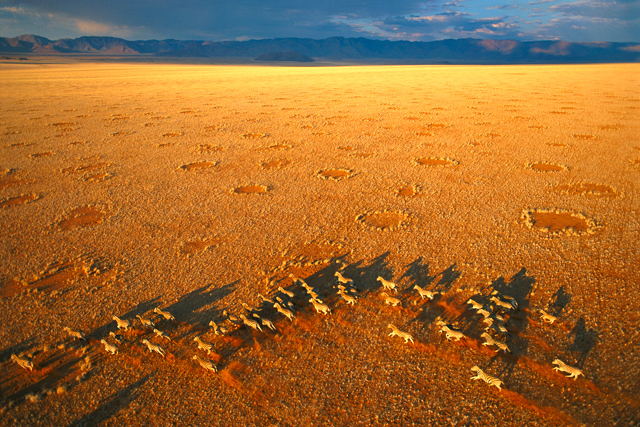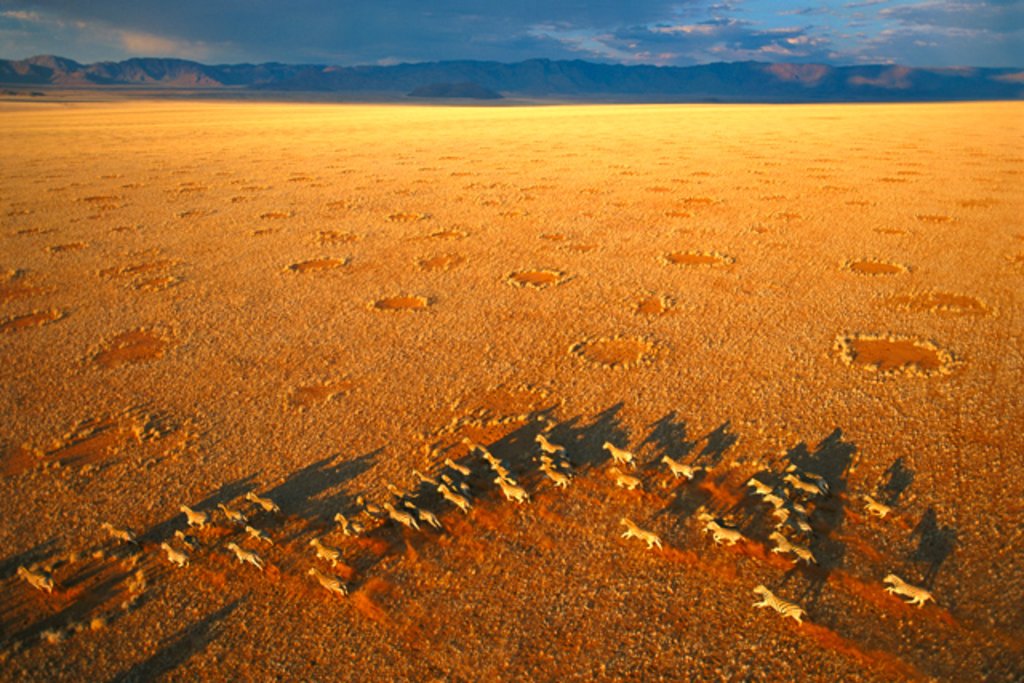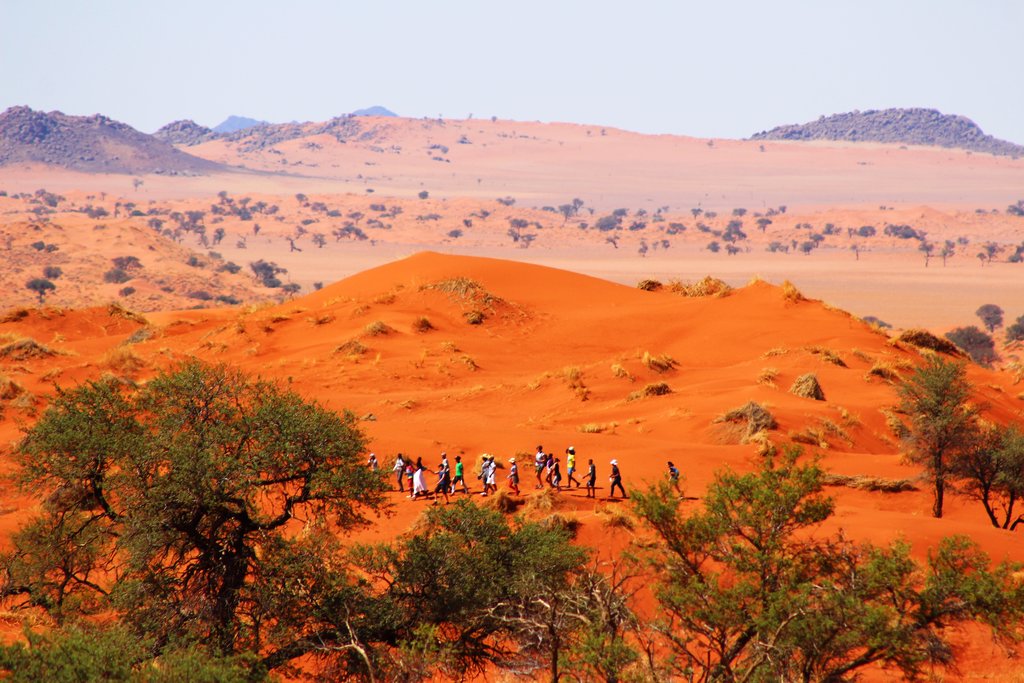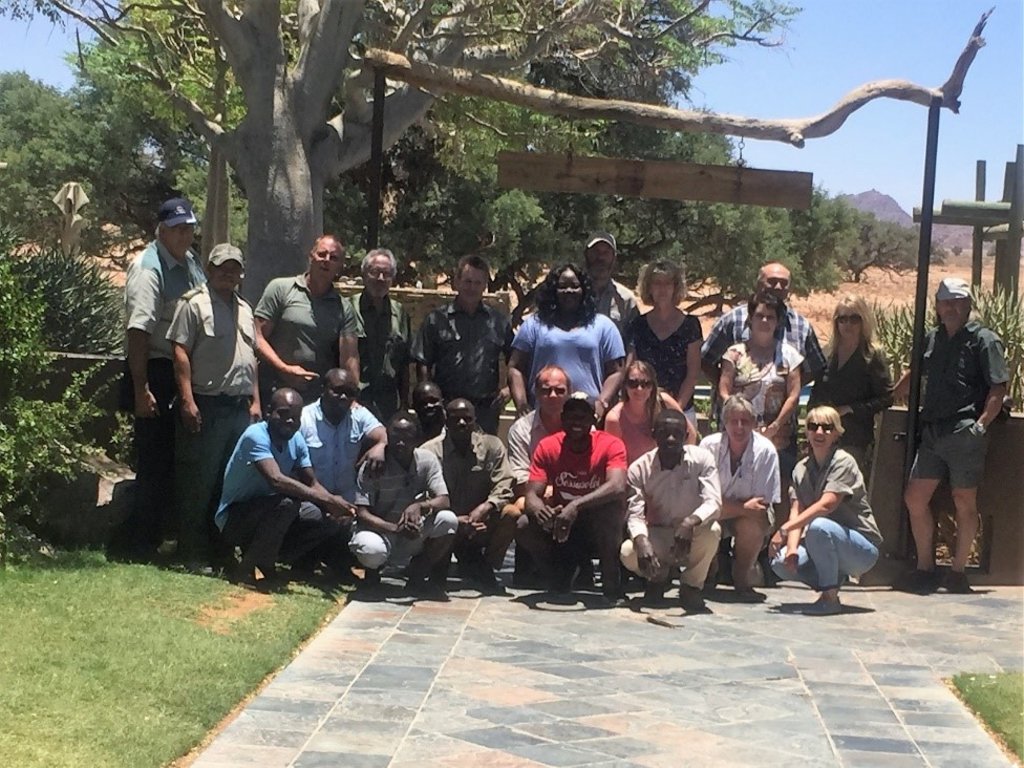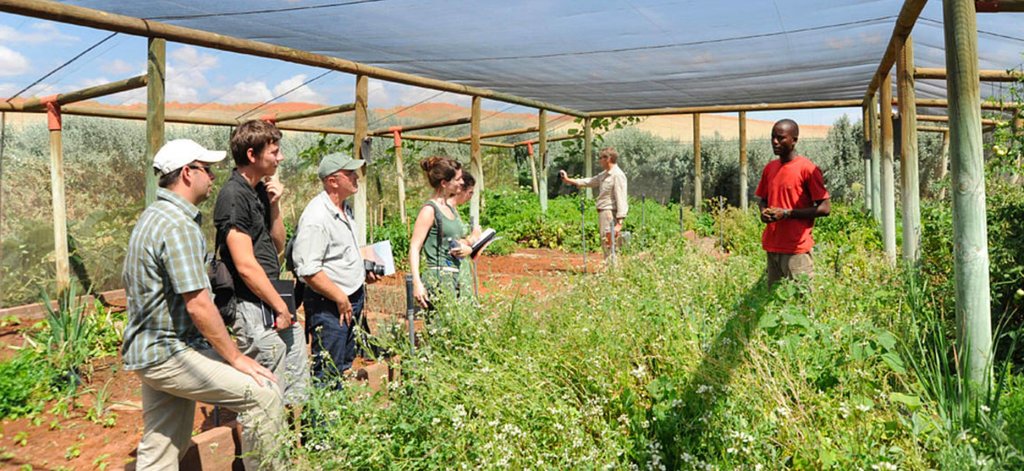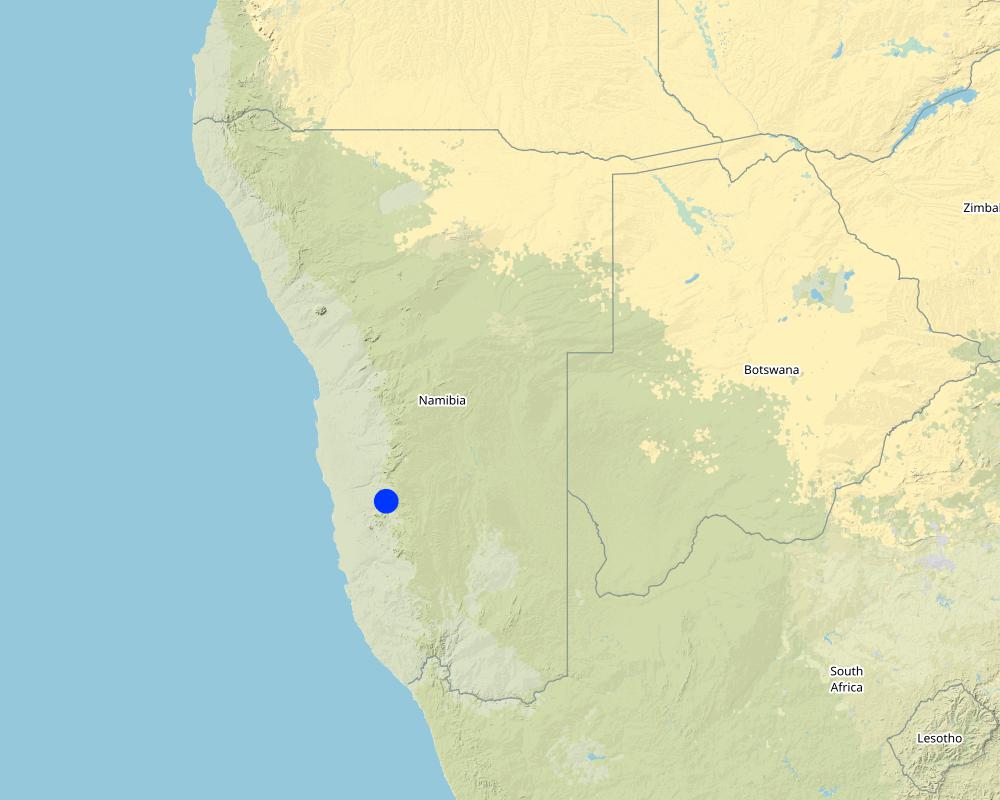Restoration of game migration routes across the Namib Desert [Namibia]
- Creación:
- Actualización:
- Compilador: Ibo Zimmermann
- Editor: –
- Revisores: Donia Mühlematter, Simone Verzandvoort, Rima Mekdaschi Studer, Joana Eichenberger
NamibRand Nature Reserve
approaches_3286 - Namibia
- Resumen completo en PDF
- Resumen completo en PDF para imprimir
- Resumen completo en el navegador
- Resumen completo (sin formato)
- Restoration of game migration routes across the Namib Desert: 2 de noviembre de 2021 (public)
- Restoration of game migration routes across the Namib Desert: 6 de octubre de 2018 (inactive)
- Restoration of game migration routes across the Namib Desert : 13 de abril de 2018 (inactive)
- Restoration of game migration routes across the Namib Desert : 23 de febrero de 2018 (inactive)
- Restoration of game migrations across Namib Desert: 12 de enero de 2018 (inactive)
Visualizar secciones
Expandir todo Colapsar todos1. Información general
1.2 Detalles de contacto de las personas de referencia e instituciones involucradas en la evaluación y la documentación del Enfoque
Nombre del proyecto que facilitó la documentación/ evaluación del Enfoque (si fuera relevante)
NamibRand Nature ReserveNombre del proyecto que facilitó la documentación/ evaluación del Enfoque (si fuera relevante)
Book project: Guidelines to Rangeland Management in Sub-Saharan Africa (Rangeland Management)Nombre de la(s) institución(es) que facilitaron la documentación/ evaluación del Enfoque si fuera relevante)
Namibia University of Science and Technology ( NUST) - Namibia1.3 Condiciones referidas al uso de datos documentados mediante WOCAT
¿Cuándo se compilaron los datos (en el campo)?
01/11/2017
El compilador y la/s persona(s) de referencia claves aceptan las condiciones acerca del uso de los datos documentados mediante WOCAT :
Sí
2. Descripción del Enfoque MST
2.1 Breve descripción del Enfoque
Seventeen former sheep farms have been joined to form the world’s largest private nature reserve aimed at regenerating biodiversity to support high-quality low-impact tourism, environmental education and research. All farm owners are members of the management association.
2.2 Descripción detallada del Enfoque MST
Descripción detallada del Enfoque MST:
The NamibRand Nature Reserve is a not-for-profit organisation in south-western Namibia. It was founded in 1984 through the initiative of one farm owner, Albi Brueckner, who agreed, with 16 neighbouring farmers, to jointly manage their 215,000 ha for nature conservation and tourism. Its aims are:
To conserve biodiversity for the benefit of future generations and protect the sensitive and fragile environment.
To create a nature reserve with a healthy and functioning ecosystem, providing a sanctuary for flora and fauna, and to facilitate seasonal migratory routes in partnership with neighbours.
To promote sustainable utilisation – through ecologically sustainable and high-quality tourism and other projects.
To achieve a commercially viable operation to ensure continuity and financial independence.
The NamibRand Nature Reserve’s contributions to biodiversity conservation, in accordance with the environmental management plan, include the following:
• Removal of over 2,000 km of fencing to reinstate wildlife migration routes.
• Re-introduction of giraffe and cheetah.
• Bolstering numbers of red hartebeest and plains zebra.
• Removal of alien invasive vegetation such as Prosopis species and replacing these with indigenous Acacias.
• Zonation according to land use areas, including the setting aside 15% of the reserve as a wilderness area.
• Limiting overnight visitors to an average of one bed per 1,000 ha, and 25 beds per location.
• Conducting annual game counts, with results posted on the website www.namibrand.org
• Monitoring the endemic Hartmann’s mountain zebra through the use of camera traps. Results are at: http://www.nnf.org.na/project/mountain-zebra-project/13/1/12.html
• Continuous monitoring of drivers and determinants of environmental change to guide the management plan. Results are posted online at: http://www.landscapesnamibia.org/sossusvlei-namib/rainfall-monitoring
• Hosting researchers to study game migration routes. Results of wildlife monitoring, through the use of GPS collars are at: http://www.landscapesnamibia.org/sossusvlei-namib/research
• Hosting the Namib Desert Environmental Education Trust (NaDEET), to empower and educate schoolchildren for a sustainable future. It operates an environmental education and sustainable living centre (www.nadeet.org).
• A lighting management plan to qualify as an international dark sky reserve that avoids negative consequences of light pollution on biodiversity – which can interfere with animal navigation, reduce the hunting success of predators and prevent moths from pollinating (http://www.darksky.org/idsp/reserves/namibrand)
• A water management plan, including monitoring of the impact of a water hole on the surrounding vegetation.
• Implementation of tourism and land use zonation plans.
• Capture and sale of live game for wildlife population management purposes.
• Plans to develop a horticultural project to grow indigenous medicinal plants for commercial production, creating local jobs and income for conservation.
Rangeland management is achieved largely through continual monitoring and control of animal populations, and the balance between functional groups of their species, and turning off the water supply where grasses are in need of rest. Local outreach efforts focus mainly on predator-livestock management on neighbouring farms.
Stakeholders comprise the land owners, who agree on joint management, and the tourism concessionaires who operate in the reserve under contract. The reserve employs 12 people who are responsible for day-to-day management and maintenance. Biodiversity and land management are funded from park fees collected by the concessionaires from tourists who stay at their establishments. This small management team is possible, because tourism concessionaires offer scenic game drives across the reserve, while on the lookout for required action. For example, guides report issues such as leaking water pipes, unusual wildlife sightings, injured animals, and trespassers (etc.) to reserve managers, who can then react.
Land owners who have connected their land to the reserve and are members of the NamibRand Nature Reserve Association have the option of serving as directors of the association, with joint decision making powers. Those who choose not can still contribute to the strategic mission of the reserve at annual general meetings.
2.3 Fotos del Enfoque
2.4 Videos del Enfoque
Comentarios, descripción breve:
Short introduction to the reserve
https://www.youtube.com/watch?v=QVQgJlBXn78
Fecha:
01/04/2015
Lugar:
NamibRand Nature Reserve
Nombre del videógrafo:
IUCN-PAPACO
Comentarios, descripción breve:
View of landscapes in the reserve
https://www.youtube.com/watch?v=8LZI2ZtPhbg
Fecha:
15/09/2014
Lugar:
NamibRand Nature Reserve
Nombre del videógrafo:
Christine Guillot, Etendues Sauvages
Comentarios, descripción breve:
Organic garden at lodge in the reserve
https://www.youtube.com/watch?v=U7RVKfeQ-0M
Fecha:
05/04/2016
Lugar:
NamibRand nature Reserve
Nombre del videógrafo:
Ticket2Utopia – Dr. Paul Goddard
2.5 País/ región/ lugares donde el Enfoque fue aplicado
País:
Namibia
Región/ Estado/ Provincia:
Southwestern Namibia in the Namib Desert.
Map
×2.6 Fechas de inicio y conclusión del Enfoque
Indique año del inicio:
1984
Si no se conoce el año preciso, indique la fecha aproximada en la que se inició el Enfoque:
10-50 años atrás
Comentarios:
The first property was purchased in 1984. The reserve was registered as a Game Reserve in 1992 and registered as the NamibRand Nature Reserve, an Association Not for Gain, in 2002
2.7 Tipo de Enfoque
- iniciativa local reciente/ innovadora
2.8 Propósitos/ objetivos principales del Enfoque
The approach aims, through participatory land use planning, to restore ecosystem function in the reserve and its surroundings to support high-quality, low-impact tourism that provides the means to support environmental education and other conservation projects.
The overall Strategic Vision of the NamibRand Nature Reserve is to manage the Pro-Namib area, alongside the Namib Desert, for the enhanced conservation of the landscape and its biodiversity.
2.9 Condiciones que facilitan o impiden la implementación de la/s Tecnología/s aplicadas bajo el Enfoque
normas y valores sociales/ culturales/ religiosos
- facilitan
The area was historically visited by migrant San people and more recently by Nama people, who have settled permanently elsewhere. Since no people were living permanently in this hyper-arid ecosystem, the use of the area exclusively for nature conservation remains uncontested.
disponibilidad/ acceso a recursos y servicios financieros
- facilitan
The establishment of the reserve was initially possible through the ample financial resources of wealthy, altruistic and philanthropic investors.
- impiden
The properties that make up the NamibRand Nature Reserve are located in a hyper-arid ecosystem. Farmers who attempted livestock farming there in the past almost all failed to establish economically viable farms, and most of them overextended themselves financially, resulting in the foreclosure of their farms. For this reason, the area became known as the “Bankruptcy Belt”. Banks were, in the past, extremely reluctant to extend loans to landowners in this area, due to the low value and low agricultural potential. In recent years, the successes of conservation and tourism have changed this situation and banks are now prepared to accept farms with such land use as collateral for extending loans.
entorno institucional
- facilitan
Progressive government company laws, such as the possibilit y to register a Section 21 company (“Association Not for Gain”) allow financial resources to be re-invested in conservation so as to further the objectives of the non-profit association. Section 21 companies also do not have to pay company taxes to the government.
colaboración/ coordinación de actores
- facilitan
Articles of Association and the management plan allow for the creation of a management team that effectively coordinates all activities on the reserve.
marco de trabajo legal (tenencia de tierra, derechos de uso de tierra y agua)
- facilitan
Rights and therefore the possibility to benefit from wildlife are enshrined in the Nature Conservation Ordinance of 1975.
- impiden
The current Nature Conservation Ordinance of 1975 does not allow for the registration of private nature reserves. The status of the land with the government thus remains as agricultural land, and law enforcement has to rely on common law such as trespassing on private property.
políticas
- facilitan
Progressive, enabling policies of the Ministry of Environment and Tourism, such as the tourism policy and the parks and neighbours policy ensure meaningful collaborations between the public and the private sector. See http://www.met.gov.na
gobernanza de tierras (toma de decisiones, implementación y aplicación)
- facilitan
Good governance is achieved through the adoption of Articles of Association and management plans. These guide decision-making and enable implementation. A set of rules, called the Vade Mecum, enable enforcement.
conocimiento de MST, acceso a apoyo técnico
- facilitan
Good networking, membership to various professional bodies and collaboration with universities and researchers ensure good knowledge about sustainable land management and technical support.
mercados (para comprar insumos, vender productos) y precios
- facilitan
A well-established tourism market to Namibia ensures a steady stream of visitors to the NamibRand Nature Reserve, enabling the collection of park fees and thus ensuring income for the reserve.
- impiden
The remoteness of the reserve, 150km from the nearest town, results in expensive transport charges for goods and inflated prices for professional services.
carga de trabajo, disponibilidad de mano de obra
- facilitan
Guides from tourism concessions on the reserve allow for sharing of workloads. Availability of human resources in the region is ample.
3. Participación y roles de las partes interesadas involucradas
3.1 Partes interesadas involucradas en el Enfoque y sus roles
- usuarios locales de tierras/ comunidades locales
17 former livestock farms owned by 12 companies, now converted to tourism enterprises
Some of them serve as directors of the NamibRand Nature Reserve Association, for joint decision making
- especialistas MST/consejeros agrícolas
12 reserve management staff
To manage the reserve
- investigadores
Visiting researchers from various academic institutions
To conduct research to help with applied research for management and "interest research" such as on “fairy circles”, which can be seen in the cover photo. The origin of these circles of bare soil surrounded by grass is still being disputed among scientists (https://www.youtube.com/watch?v=2VNyo9AoA8I). There is a Wildlife monitoring programme partnership with Namibia University of Science and Technology and the Greater Sossusvlei Landscape Association
- profesores/ niños en edad escolar/ estudiantes
4 full-time teachers at NADEET and 10 instructors at hospitality training centre.
To expose about 1000 visiting students per year to environmental education and to provide vocational training to about 100 trainees per year.
- ONG
Cheetah Conservation Fund and Giraffe Conservation Fund.
To reintroduce predators and wild herbivore species.
- sector privado
Neighbouring farms
Co-management of the larger landscape with like-minded neighbours, as indicated at: http://www.landscapesnamibia.org/sossusvlei-namib/
- gobierno nacional (planificadores, autoridades)
Ministry of Environment and Tourism.
To assist with law enforcement and wildlife monitoring.
- organización internacional
Member of IUCN
For advocacy and knowledge sharing.
3.2 Involucramiento de los usuarios locales de tierras/ comunidades locales en las distintas fases del Enfoque
| Involucramiento de los usuarios locales de tierras/ comunidades locales | Especifique quién se involucró y describa las actividades | |
|---|---|---|
| iniciación/ motivación | auto-movilización | The founding farm owner approached philanthropic donors to buy neighbouring farms and invest in tourism facilities and environmental education centre. |
| planificación | apoyo externo | In 1991, external experts provided advice for planning of the reserve. Influential persons involved included Chris Brown, Hugh Berry and Haino Rumpf of the Ministry of Environment, and Mary Seely of the Desert Research Foundation. |
| implementación | auto-movilización | Management staff were appointed in 1991, and paid for from the conservation levy raised from use of tourism facilities in the reserve. |
| monitoreo y evaluación | auto-movilización | Reserve management staff do the monitoring, paid for by the conservation levy. |
| research | apoyo externo | Research institutions conduct research after paying a small service fee. |
3.4 La toma de decisiones en la selección de Tecnología(s) MST
Especifique quién decidió la selección de las Tecnología/ Tecnologías a implementarse:
- principalmente usuarios de tierras con el apoyo de especialistas MST
Explique:
The Reserve's vision and mission were set up by its directors, who comprise farm owners willing to serve in this decision making role, at the Initiation workshop in 1991. Management actions were then Implemented under the guidance of various specialists.
Especifique las bases que sustentaron la toma de decisiones:
- la evaluación de conocimiento MST bien documentado (la toma de decisiones se basa en evidencia)
- hallazgos de investigaciones
- la experiencia personal y opiniones (no documentadas)
4. Apoyo técnico, fortalecimiento institucional y gestión del conocimiento
4.1 Construcción de capacidades / capacitación
¿Se proporcionó la capacitación a usuarios de tierras/ otras partes interesadas?
Sí
Especifique quién fue capacitado:
- usuarios de tierras
- personal de campo/ consejeros
- Tourism concessionaires
Forma de capacitación:
- en el contexto de trabajo
- áreas de demostración
- reuniones públicas
Forma de capacitación:
- Exchange visits
Temas avanzados:
Biodiversity conservation, financial management, tourism best practices, principles of co-management, human-wildlife conflict resolution, rehabilitation.
4.2 Servicio de asesoría
¿Los usuarios de tierras tienen acceso a un servicio de asesoría?
Sí
Especifique si servicio proporcionado se realizó:
- en los campos de los usuarios de tierras
- en centros permanentes
Describa/ comentarios:
Advice is provided by the Namibia Chamber of Environment, the Namibia Nature Foundation, the Ministry of Environment and Tourism Resource Centre, the Namibia University of Science and Technology, the Giraffe Conservation Fund and other wildlife biologists on issues such as determination of wildlife carrying capacities.
4.3 Fortalecimiento institucional (desarrollo institucional)
¿Se establecieron o fortalecieron instituciones mediante el Enfoque?
- sí, mucho
Especifique el nivel o los niveles en los que se fortalecieron o establecieron las instituciones:
- local
Describa la institución, roles y responsabilidades, miembros, etc.
NamibRand Nature Reserve Association. All land owners are members, who elect the directors. They manage the reserve according to an agreed strategy.
Especifique el tipo de apoyo:
- financiero
Proporcione detalles adicionales:
Hiring of lawyers and auditors/accountants to establish the association.
4.4 Monitoreo y evaluación
¿El monitoreo y la evaluación forman parte del Enfoque?
Sí
Comentarios:
Impacts are monitored to feed back into management.
Si respondió que sí, ¿la documentación se utilizará para monitoreo y evaluación?
No
4.5 Investigación
¿La investigación formó parte del Enfoque?
Sí
Especifique los temas:
- ecología
Proporcione detalles adicionales e indique quién hizo la investigación:
Determination of wildlife carrying capacities by wildlife biologists.
5. Financiamiento y apoyo material externo
5.1 Presupuesto anual para el componente MST del Enfoque
Si no se conoce el presupuesto anual preciso, indique el rango:
- 100,000-1,000,000
Comentarios (ej. fuentes principales de financiamiento/ donantes principales):
Self funded from conservation levy collected from tourism income.
5.2 Apoyo financiero/material proporcionado a los usuarios de tierras
¿Los usuarios de tierras recibieron financiamiento/ apoyo material para implementar la Tecnología/ Tecnologías? :
No
5.4 Crédito
¿Se proporcionó crédito bajo el Enfoque para actividades MST?
No
5.5 Otros incentivos o instrumentos
¿Se usaron otros incentivos o instrumentos para promover la implementación de Tecnologías MST?
No
6. Análisis de impacto y comentarios de conclusión
6.1 Impactos del Enfoque
¿El Enfoque empoderó a los usuarios locales de tierras, mejoró el involucramiento de las partes interesadas?
- No
- Sí, un poco
- Sí, moderadamente
- Sí, mucho
Interest in owning land has greatly increased. Land prices have risen and more tourism establishments were built.
¿El Enfoque facilitó la toma de decisiones basada en evidencia?
- No
- Sí, un poco
- Sí, moderadamente
- Sí, mucho
Through monitoring, to determine wildlife carrying capacity.
¿El Enfoque ayudó a los usuarios de tierras a implementar y mantener Tecnologías MST?
- No
- Sí, un poco
- Sí, moderadamente
- Sí, mucho
Research and expert advice drives appropriate management for the ecology. There are no more sheep and associated weeds, while wildlife numbers increased.
¿El Enfoque mejoró la coordinación e implementación efectiva en costos de MST?
- No
- Sí, un poco
- Sí, moderadamente
- Sí, mucho
By applying economies of scale. Managed holistically by a small, effective team.
¿El Enfoque movilizó/mejoró el acceso a recursos financieros para implementar MST?
- No
- Sí, un poco
- Sí, moderadamente
- Sí, mucho
Through awarding of tourism concessions and collection of park fees.
¿El Enfoque mejoró el conocimiento y capacidades de los usuarios para implementar MST?
- No
- Sí, un poco
- Sí, moderadamente
- Sí, mucho
Through various training and research activities.
¿El Enfoque mejoró el conocimiento y capacidades de otras partes interesadas?
- No
- Sí, un poco
- Sí, moderadamente
- Sí, mucho
Through accessing information and gaining knowledge from research.
¿El Enfoque construyó/ fortaleció instituciones, colaboración entre partes interesadas?
- No
- Sí, un poco
- Sí, moderadamente
- Sí, mucho
Through establishment of the association, appointment of the management team and information sharing.
¿El Enfoque mitigó conflictos?
- No
- Sí, un poco
- Sí, moderadamente
- Sí, mucho
Through implantation of a joint management plan and shared vision.
¿El Enfoque empoderó a grupos en desventaja social y económica?
- No
- Sí, un poco
- Sí, moderadamente
- Sí, mucho
There are no local communities living within the area, but children from all over the country visit the environmental education centre.
¿El Enfoque mejoró la equidad de género y empoderó a las mujeres y niñas?
- No
- Sí, un poco
- Sí, moderadamente
- Sí, mucho
Through policies prohibiting gender discrimination, implemented by tourism enterprises.
¿El Enfoque alentó a jóvenes/ la siguiente generación de usuarios de tierras a involucrarse con MST?
- No
- Sí, un poco
- Sí, moderadamente
- Sí, mucho
Through the environmental education and vocational training centres.
¿El Enfoque mejoró cuestiones de tenencia de tierra/ derechos de usuarios que obstaculizaron la implementación de la Tecnologías MST?
- No
- Sí, un poco
- Sí, moderadamente
- Sí, mucho
Through establishment of the Association for joint management and guidelines that are followed in the management plan.
¿El Enfoque resultó en mejor seguridad alimentaria/ mejoró la nutrición?
- No
- Sí, un poco
- Sí, moderadamente
- Sí, mucho
Through the organic garden of 1 ha irrigated with borehole water and featuring in one of the Youtube videos, the improved financial status of the area and access to meat of culled animals for reserve workers and tourists.
¿El Enfoque mejoró el acceso a los mercados?
- No
- Sí, un poco
- Sí, moderadamente
- Sí, mucho
Due to serving tourism needs.
¿El Enfoque llevó a un acceso mejorado a tierra y saneamiento?
- No
- Sí, un poco
- Sí, moderadamente
- Sí, mucho
Workers have access to borehole water pumped for tourism.
¿El Enfoque llevó a un uso más sostenible/ fuentes de energía?
- No
- Sí, un poco
- Sí, moderadamente
- Sí, mucho
Solar power is used to generate electricity and heat water.
¿El Enfoque mejoró la capacidad de los usuarios de tierras a adaptarse a los cambios climáticos/ extemos y mitigar desastres relacionados al clima?
- No
- Sí, un poco
- Sí, moderadamente
- Sí, mucho
Based on naturally adapted species that are able to migrate.
¿El Enfoque llevó a oportunidades de empleo, ingresos?
- No
- Sí, un poco
- Sí, moderadamente
- Sí, mucho
The current land use based on tourism supports times more employees per unit area compared with former sheep farming.
National economy:
- No
- Sí, un poco
- Sí, moderadamente
- Sí, mucho
Contribution to national income through higher wages in the tourism industry.
6.2 Motivación principal del usuario de la tierra para implementar MST
- incremento de la renta(bilidad), proporción mejorada de costo-beneficio
Through tourism, compared with former sheep farming.
- reducción de la degradación de la tierra
Reliance on more appropriate land use.
- reducción del riesgo de desastres naturales
Nature takes better care of itself and is more resilient to drought than sheep farming was.
- carga de trabajo reducida
Sheep herders are no longer needed and there is a small, efficient management team, assisted by information provided through tour guides when their attention is required.
- prestigio, presión social/ cohesión social
Through membership of the association.
- conciencia medioambiental
Forms the vision of the association.
- conocimiento y capacidades mejorados de MST
Improved resource management due to expert knowledge.
- mejoramiento estético
There are rules to prevent unsightly buildings and maintain the clear night sky, free from light pollution.
- mitigación de conflicto
Through the association constitution and discussions at planning meetings working towards the common goal
- Philantropic
Wanting to do good and contribute to conservation.
6.3 Sostenibilidad de las actividades del Enfoque
¿Pueden los usuarios de tierras sostener lo que se implementó mediante el Enfoque (sin apoyo externo)?
- sí
Si respondió que sí, describa cómo:
Through income largely derived from tourism and partly from sale of captured game animals in accordance with the environmental management plan.
6.4 Fortalezas/ ventajas del Enfoque
| Fuerzas/ ventajas/ oportunidades desde la perspectiva del usuario de la tierra |
|---|
| The reserve is centrally and holistically managed by a team. |
| Resilience attained by the large unfenced ecosystem. |
| Land users coming together to sign and form a legally recognised body that is more robust. |
| Tourism is more profitable and sustainable than agriculture for such a hyper arid region. |
| Fuerzas/ ventajas/ oportunidades desde la perspectiva del compilador o de otra persona de referencia clave |
|---|
| Resilience to climate change through natural resources, using the competitive advantage of nature. |
| Private property excludes communal demands and allows fast and easy decision making on land use. |
6.5 Debilidades/ desventajas del Enfoque y formas de sobreponerse a ellos
| Debilidades/ desventajas/ riesgos desde la perspectiva del usuario de la tierra | ¿Cómo sobreponerse a ellas? |
|---|---|
| There is currently no legislative support from government for protection of private land. | The new wildlife bill being drafted makes provision for privately protected areas. |
| In the eyes of the Ministry of Lands, there are only two types of land, either urban and gazetted (e.g. parks) or agricultural (subject to land tax). | Include a third category of land for protected areas, such as the desert margin being non-agricultural. |
7. Referencias y vínculos
7.1 Métodos/ fuentes de información
- entrevistas con usuarios de tierras
Chief Executive Officer of the NamibRand Nature Reserve
7.2 Referencias a publicaciones disponibles
Título, autor, año, ISBN:
A Guidebook to the NamibRand Nature Reserve, 2017, ISBN 978-99945-85-14-4
¿Dónde se halla disponible? ¿Costo?
Local bookshops for approximately USD25
7.3 Vínculos a la información relevante disponible en línea
Título/ descripción:
Website of NamibRand Nature Reserve
URL:
www.namibrand.org
Título/ descripción:
Website of Namib Desert Environmental Education Trust
URL:
www.nadeet.org
Vínculos y módulos
Expandir todo Colapsar todosVínculos
No hay vínculos
Módulos
No se hallaron módulos


